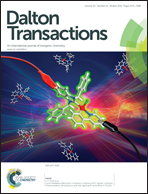Ligand effects on the electrochemical behavior of [Fe2(CO)5(L){μ-(SCH2)2(Ph)P![[double bond, length as m-dash]](https://www.rsc.org/images/entities/char_e001.gif) O}] (L = PPh3, P(OEt)3) hydrogenase model complexes†
O}] (L = PPh3, P(OEt)3) hydrogenase model complexes†
Abstract
In this paper we study the influence of substituting one CO ligand in [Fe2(CO)6{μ-(SCH2)2(Ph)P![[double bond, length as m-dash]](https://www.rsc.org/images/entities/char_e001.gif) O}] (1) by better σ-donor L ligands affording [Fe2(CO)5(L){μ-(SCH2)2(Ph)P
O}] (1) by better σ-donor L ligands affording [Fe2(CO)5(L){μ-(SCH2)2(Ph)P![[double bond, length as m-dash]](https://www.rsc.org/images/entities/char_e001.gif) O}] {L = PPh3 (2) and P(OEt)3 (3)} in relation to the steric interactions and the voltammetric behavior. Cyclic voltammetric investigations under N2 and CO showed remarkable differences in the electrochemical behaviour of complexes 2 and 3: (i) Complex 2 tends to expel PPh3 upon reduction whereas complex 3 exhibits chemical reversibility and (ii) Under CO, complex 3 reacts with CO affording a new compound P, which shows a reversible wave at E1/2 ∼ −0.9 V (vs. ferrocenium/ferrocene couple). The presence of CO assists the formation of 1 after electrochemically induced loss of PPh3 during the voltammetric experiment of 2. Using DFT calculations we provide an explanation for the difference in stabilities between the Fe–PPh3 and Fe–P(OEt)3 bonds.
O}] {L = PPh3 (2) and P(OEt)3 (3)} in relation to the steric interactions and the voltammetric behavior. Cyclic voltammetric investigations under N2 and CO showed remarkable differences in the electrochemical behaviour of complexes 2 and 3: (i) Complex 2 tends to expel PPh3 upon reduction whereas complex 3 exhibits chemical reversibility and (ii) Under CO, complex 3 reacts with CO affording a new compound P, which shows a reversible wave at E1/2 ∼ −0.9 V (vs. ferrocenium/ferrocene couple). The presence of CO assists the formation of 1 after electrochemically induced loss of PPh3 during the voltammetric experiment of 2. Using DFT calculations we provide an explanation for the difference in stabilities between the Fe–PPh3 and Fe–P(OEt)3 bonds.
![Graphical abstract: Ligand effects on the electrochemical behavior of [Fe2(CO)5(L){μ-(SCH2)2(Ph)P [[double bond, length as m-dash]] O}] (L = PPh3, P(OEt)3) hydrogenase model complexes](/en/Image/Get?imageInfo.ImageType=GA&imageInfo.ImageIdentifier.ManuscriptID=C5DT00064E&imageInfo.ImageIdentifier.Year=2015)

 Please wait while we load your content...
Please wait while we load your content...
![[double bond, length as m-dash]](https://www.rsc.org/images/entities/h2_char_e001.gif) O}] (L = PPh3, P(OEt)3) hydrogenase model complexes
O}] (L = PPh3, P(OEt)3) hydrogenase model complexes